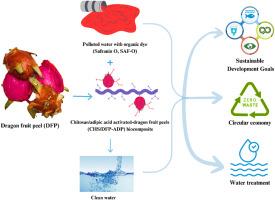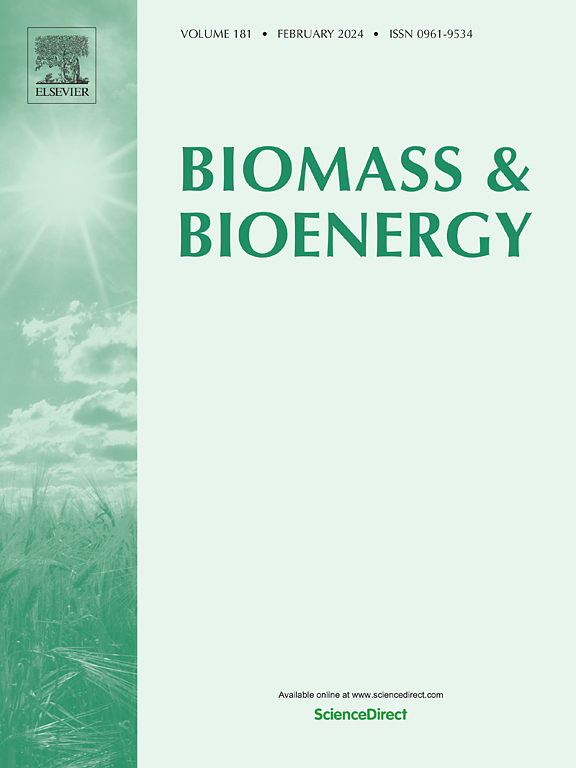Bio-sourced multifunctional adsorbent of chitosan and adipic acid activated-dragon fruit peels for organic dye removal from water: Eco-friendly management and valorization of biomass
IF 5.8
2区 生物学
Q1 AGRICULTURAL ENGINEERING
引用次数: 0
Abstract
Employing sustainable biomaterials obtained from waste biomass and biopolymers provides a very promising method for eliminating organic dyes from wastewater. This study presents a novel adsorbent of modified dragon fruit peels and chitosan, addressing wastewater treatment and environmental waste management. Precisely, a bio-sourced multifunctional (high level of functional groups) adsorbent (hereinafter, CHS/DFP-ADP) was developed from chitosan and adipic acid activated-dragon fruit (Hylocereus polyrhizus) peels. This biomaterial was applied to effectively adsorb organic pollutants (safranin O dye, SAF-O) from water. The adsorption variables, namely A: CHS/DFP-ADP dosage (0.02–0.08 g), B: pH (4–10), and C: duration (10–40 min), were modeled and optimized using the Box-Behnken Design (BBD). The results of the BBD model showed the optimum adsorption parameters for achieving the highest level of SAF-O removal (94.83 %) were as follows: CHS/DFP-ADP does = 0.049 g, the pH ∼ 10, and the contact duration = 40 min. The experimental results on the dye adsorption by CHS/DFP-ADP demonstrated conformity with the pseudo-first-order and Freundlich models. The biomaterial demonstrated a significant capability to adsorb SAF-O dye, with an adsorption capacity of 607.2 mg/g. The adsorption process of the cationic dye on the CHS/DFP-ADP involves several interactions, such as Yoshida H-bonding, electrostatic forces, n-π, and H-bonding. This work aligns with the principles of green chemistry and sustainable development, offering an innovative approach to tackle environmental concerns and promote the circular economy. The present effort meets several Sustainable Development Goals (SDGs), such as SDG 6 (Clean Water and Sanitation), SDG 12 (Responsible Consumption and Production), SDG 13 (Climate Action), and SDG 14 (Life Below Water).

用于去除水中有机染料的壳聚糖和己二酸活化龙果皮生物源多功能吸附剂:生物质的生态友好型管理和价值评估
利用从废弃生物质和生物聚合物中获得的可持续生物材料,为消除废水中的有机染料提供了一种非常有前景的方法。本研究提出了一种改性火龙果皮和壳聚糖的新型吸附剂,以解决废水处理和环境废物管理问题。确切地说,研究人员利用壳聚糖和己二酸活化火龙果果皮,开发了一种生物源多功能(高水平官能团)吸附剂(以下简称 CHS/DFP-ADP)。这种生物材料可用于有效吸附水中的有机污染物(黄芳苷 O 染料,SAF-O)。吸附变量,即 A:CHS/DFP-ADP 用量(0.02-0.08 克)、B:pH 值(4-10)和 C:持续时间(10-40 分钟),采用方框-贝肯设计(BBD)进行建模和优化。BBD 模型的结果表明,达到最高 SAF-O 去除率(94.83%)的最佳吸附参数如下:CHS/DFP-ADP does = 0.049 g,pH ∼ 10,接触时间 = 40 min。CHS/DFP-ADP 吸附染料的实验结果表明符合伪一阶模型和 Freundlich 模型。该生物材料对 SAF-O 染料具有显著的吸附能力,吸附容量为 607.2 mg/g。阳离子染料在 CHS/DFP-ADP 上的吸附过程涉及多种相互作用,如吉田 H 键、静电力、n-π 和 H 键。这项工作符合绿色化学和可持续发展的原则,为解决环境问题和促进循环经济提供了一种创新方法。目前的工作符合多个可持续发展目标(SDGs),如 SDG 6(清洁水和卫生设施)、SDG 12(负责任的消费和生产)、SDG 13(气候行动)和 SDG 14(水下生命)。
本文章由计算机程序翻译,如有差异,请以英文原文为准。
求助全文
约1分钟内获得全文
求助全文
来源期刊

Biomass & Bioenergy
工程技术-能源与燃料
CiteScore
11.50
自引率
3.30%
发文量
258
审稿时长
60 days
期刊介绍:
Biomass & Bioenergy is an international journal publishing original research papers and short communications, review articles and case studies on biological resources, chemical and biological processes, and biomass products for new renewable sources of energy and materials.
The scope of the journal extends to the environmental, management and economic aspects of biomass and bioenergy.
Key areas covered by the journal:
• Biomass: sources, energy crop production processes, genetic improvements, composition. Please note that research on these biomass subjects must be linked directly to bioenergy generation.
• Biological Residues: residues/rests from agricultural production, forestry and plantations (palm, sugar etc), processing industries, and municipal sources (MSW). Papers on the use of biomass residues through innovative processes/technological novelty and/or consideration of feedstock/system sustainability (or unsustainability) are welcomed. However waste treatment processes and pollution control or mitigation which are only tangentially related to bioenergy are not in the scope of the journal, as they are more suited to publications in the environmental arena. Papers that describe conventional waste streams (ie well described in existing literature) that do not empirically address ''new'' added value from the process are not suitable for submission to the journal.
• Bioenergy Processes: fermentations, thermochemical conversions, liquid and gaseous fuels, and petrochemical substitutes
• Bioenergy Utilization: direct combustion, gasification, electricity production, chemical processes, and by-product remediation
• Biomass and the Environment: carbon cycle, the net energy efficiency of bioenergy systems, assessment of sustainability, and biodiversity issues.
 求助内容:
求助内容: 应助结果提醒方式:
应助结果提醒方式:


